The Balloon Observer Badge of the army is one of the legendary badges from the end of the III. Reich. It was instituted for the services of the army observers, who rose into the air in hydrogen-filled balloons near the front, at a time when the German forces used weapon systems like night-vision devices, rockets were sent to London, jet fighters scared the Allies over the German Reich, and the Horton brothers completed the highly-advanced flying wing bomber, the Horten H IX.
Articles about this badge have already been published in various media. Most of these publications are unfortunately incomplete or very speculative. Based on the available facts, this essay is intended to try to provide more clarity on this exciting topic.
The award regulations1 of the proficiency badge, which was not a combat badge, approved on July 8, 1944 read as follows:
419. Balloon Observer Badge.
Decree of the institution of the Balloon Observer Badge.
1. In recognition of the efforts of the balloon observers, the Führer has approved the institution
of the Balloon Observer Badge.
2. The Balloon Observer Badge is a proficiency badge.
3. The Balloon Observer Badge will be worn on the left side of the chest.
4. The responsible superiors are responsible for compliance with the regulations.
5. The implementation regulations are issued by Gen. d. Art. B. Chief Gen. St. D. H.
On behalf
Schmundt.
O. K. H., 8/7/44
PA / P 5 (f).
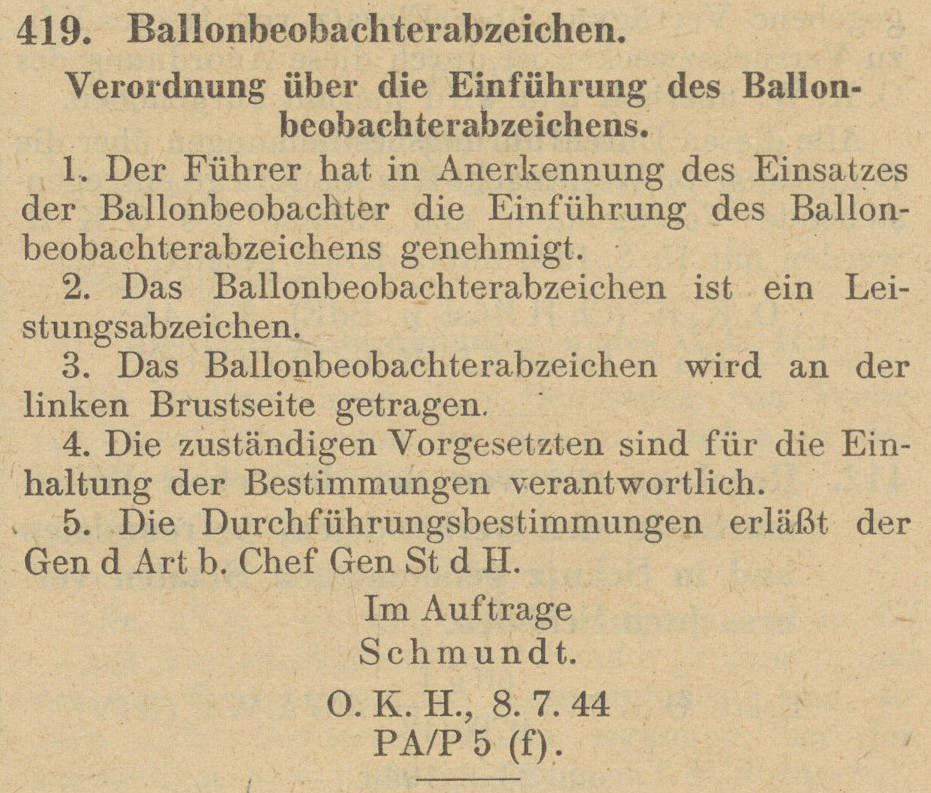
Award Regulations for the Balloon Observer Badge
I. The balloon observer badge is a proficiency badge for the observers in captive balloons who have proven themselves at the front line. It can be awarded to officers, NCOs, and privates.
II. The balloon observer badge is worn on the left side of the breast like a war badge. If an Infantry Assault Badge is present, the Balloon Observer Badge will be worn to the left of it.
III. The balloon observer badge is awarded in three grades:
The conditions for the award are:
1. Grade ………… 20 points
2. Grade ………… 45 points
3. Grade ………… 75 points
IV. The point system was defined as follows:
1. reconnaissance of important tactical targets, which are especially important, such as troop concentrations, movements, per target (1) point
2. fire control of the artillery, per target ....................... (1) point
3. front deployment, for four hours each ....................... (1) point
4. observing while under fire from airplanes or artillery:
a) when no damage occurred to the balloon or the ground post .. (2) points
b) damage to the balloon or the ground post ...................... (3) points
5. parachute jump from the gondola for urgent reason:
a) first jump ....................... (10) points
b) each additional ....................... (5) points
The decision about the evaluation is made by:
for point 1: the troop leader (Div. Kdr., Kampfgr. Führer) or on his behalf the Art. Führer on request
for point 2: the artillery leader on request
for point 3, 4 and 5: the battery leader
V. The Balloon Observer Badge is awarded by the General der Artillerie im Generalstab des Heeres. The awardee will receive an award document. At General der Artillerie im Generalstab des Heeres award lists are kept of all issued Balloon Observer Badges.
VI. The application for the award of the Balloon Observer Badge is to be sent through official channels to General der Artillerie im Generalstab des Heeres. A certified copy of the list to be kept for the balloon flights of the observers must be attached to the application. When a soldier leaves the unit, an excerpt from the list must be added to the Soldbuch.
VII. The badge and the award certificate will be sent directly to the submitting department together with the
submitted documents.
VIII. Transitional provision
The point evaluation according to IV starts on 1 January 1944. For times further back, a maximum of 20 points can be credited for the 1. Grade. The balloon flight records or the annexes to the war diaries are the basis for the evaluation of past achievements.
Confirmation is given - in contrast to Section IV - by the commander of the Observer. Dept. to which the observer was subordinate at the time of the services. The applications for former balloon observers are processed by the Observer Dept. to which the observer was attached earlier and are submitted. If balloon observers have documents from their previous assignment work with other units, they must send them to the responsible submission department.
IX. The award is to be entered in the war diary, and into the Wehrpaß and Soldbuch of the soldier on loan. The award is to be announced by order of the day. Replacement for lost or damaged badges must be requested through official channels, stating the confirmed reason. Only the holder of an award certificate is entitled to wear the Balloon Observer Badge. Unauthorized carrying is a punishable offense according to § 132a of criminal code. Only the highest awarded level of the balloon observer badge is to be worn. If the conditions for a higher level are already met at the time of the first award, the badge will only be awarded for this level.
O. K. H. 7/15/44
Gen. d. Art. B. Chief Gen. St. d. H.
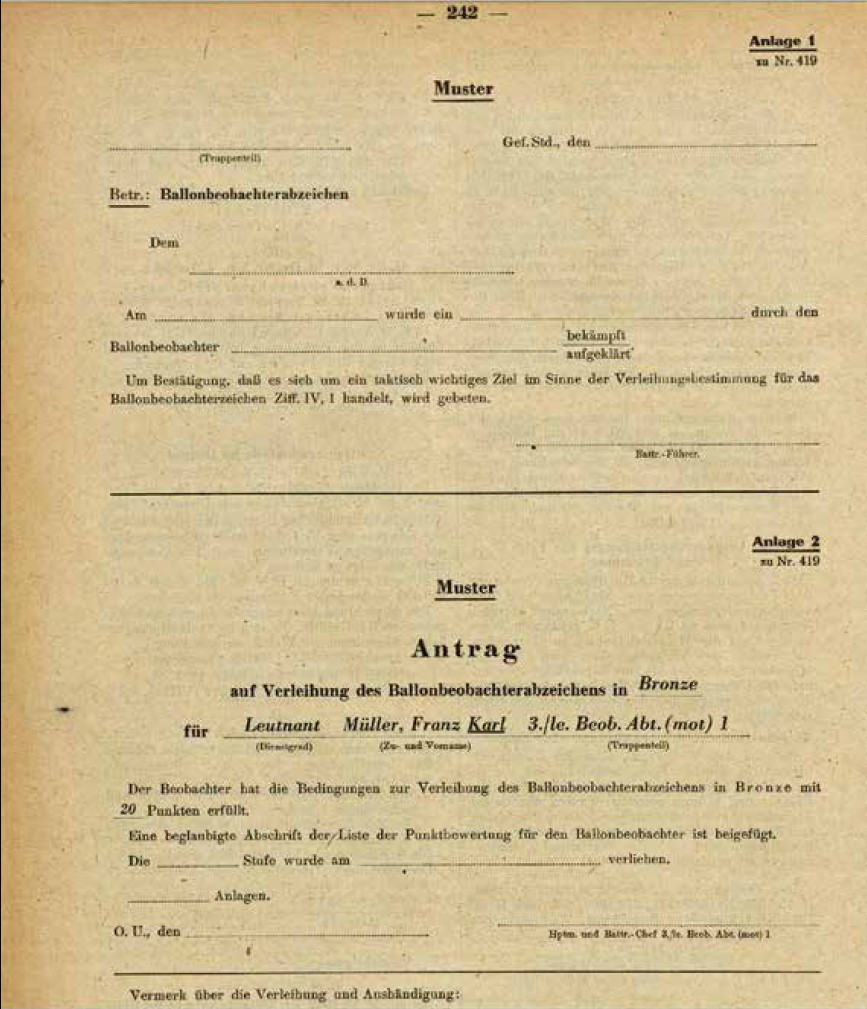
On page 215 of the Reichsgesetzblatt No. 46 (law gazette), published on 29 September 1944, the eighth edition regarding the protection of war badges of the Wehrmacht, dated 7 September 1944 is announced and thus the Balloon Observer Badge is officially introduced. It reads like this:
Eighth Implementing Ordinance on the Protection of Wehrmacht Arms Badges
from September 7, 1944.
On the basis of § 4 of the decree on the Protection of War Badges of the Wehrmacht of May 3, 1942 (Reichsgesetzbl. I p.277) I determine:
The Implementing Ordinance of 13 July 1942 (Reichsgesetzbl. I p.501) in the version of the Seventh Implementing Ordinance of 6 July 1944 (Reichsgesetzbl. I p.171) is supplemented as follows: […] Under II., letter b, in front of the "Army Paratrooper Badge" add: "1." and after No. 1. add: "2. Balloon Observer Badge ”.
Führer Hauptquartier 7 September 1944.
The Chief of the High Command of the Wehrmacht
Keitel
The Balloon Observer Badge could therefore be awarded from this point in time onwards. The so far unsolved question is: Was this badge ever awarded?
Fortunately, Dr. Kurt-Gerhard Klietmann opened after the war his private “Institute for Scientific Phaleristics”2 in Berlin. He actively sought mail and personal contact with contemporary witnesses in order to verify the existence of the medals and decorations instituted late in the war. The correspondence from the immediate post-war period with people who came into direct contact with these topics and especially with the topic of the Balloon Observer Badge are still preserved today. Among other things, there is an indication of early considerations about the creation of the badge in a statement by A. Ramminger of 1978:
“The creation of the Balloon Observer Badge was already discussed at the beginning of the war, but it was not until the autumn of 1943, when the increasing air superiority of the enemy threatened the balloon observers more and more, that the considerations for the creation of a Balloon Observer Badge took place under the head of Group III (reconnaissance artillery), Colonel Hans Joachim Froben, encouraged by his predecessor, Colonel Meridies. Together with the experienced balloon observer Oblt. Uhde, Colonel H.J. Froben created a points evaluation system for the award of the badge, ... “3
Corresponding information about the masterminds behind the award can be found in Friedrich Wilhelm Schmidt as early as 1956:
“[…] From the beginning of 1944 to the beginning of 1945 I was a clerk in Section III of the General of the Artillery at the Chief of the Army General Staff under Colonel Froben and worked also partly on the affairs of the balloon observer badge. […] ”4
He later wrote:
“ […] The department III was in charge of the design, award, etc. of the badge. of the Gen. d. Art. B. Ch. Gen. St. d. H., at that time led by Colonel Froben, whose assistant I was. [...] “5
The statements made to Dr. Klietmann in letter form were triggered by his advertisement in the “Bulletin for former members of the B. Dept.”. He placed the ad in the 1950s as a direct appeal to the former soldiers of the observer departments in order to be able to clear up any ambiguities regarding the awarding of the Balloon Observer Badge. So the creator of the badge himself, Hans Joachim Froben, answered and wrote:
“[…] From autumn 1943 onwards, I had been a group leader in the staff of Gen. d. Art. At the Chief Gen. Staff d. Heeres and also took care of the balloon units. According to the regulations, the balloon observers, who were increasingly at risk, could not receive an Iron Cross for their special services and only the KVK with great difficulties. This was seen as unfair by the front. Due to various suggestions from outside I got in touch with the clerk for matters of decorations. I then arranged for a reliable balloon observer to be commanded to my office, and then, taking into account the conditions at the front, laid down the regulations for the award in various stages. I then discussed this proposal again with the person in charge named above, and the final version of the regulation was determined. The announcement was then officially initiated after the matter had been presented to Adolf Hitler (by Gen. Schmundt) [...]6 Awards took place. As far as I can remember, these were pronounced by the tactical leader of the section in which the balloon was deployed. This was mostly a division commander, a section commander, a leader of an independent combat group. […] I still remember that a silver badge was awarded to Oblt., now Dr. Ing., Alfred Uhde, […]“7
Uhde himself writes regarding this subject:
“As the leader of one of the most frequently used balloon units, I was ordered to Gen. d. Art. of the O.K.H. to work out the conditions for the awarding of the balloon observer badge at Mr. Froben’s office and to give informations. […] I myself was also proposed for the Balloon Observer Badge in Silver and later received an award certificate together with a statement that the badge would follow later, [...] The award certificate is unfortunately no longer in my possession, it must have been lost towards the end of the war. “8
Even more contemporary witnesses speak up. Peter Stegmann wrote in November 1958:
“[...] I would like to inform you that I was awarded the first grade of this badge on December 12, 1944. The relevant document was given to me at the time, but the badge itself could not be presented. I was officially informed when the document was presented that it should be provided later. [...] The award document was entered into my Soldbuch on 2 January 1945. “9
Mr Stegmann’s awards and documents were auctioned 2013 by a German auction house and sold into an US-collection.
Rudolf Kessler writes in a letter in December 1958:
"In response to your request in bulletin no. 11, I inform you that I was awarded the 1. grade of the Balloon Observer Badge on 12 December 1944 as the leader of the balloon platoon (bo) 20. The certificate of ownership was issued by headquarters OKH Gen. d. Art. by the Chief of the General Staff of the Army, entry in the Soldbuch was made. The actual badge was not issued [...] “10
Observer detachment 20 was brought into being as early as 1936. Its long history contained - probably exemplary for all other departments - among other things these peculiarities: The new year 1944 began with a thaw, rain, and mud. A new central organization of the artillery command in the bridgehead initially brought some difficulties in the otherwise good cooperation with the “shooting party.” In addition, the new commander, General Schörner, showed little understanding for an observer detachment which he called “observation freaks.” That sparked strange incidents. So he personally arrested a corporal of a sound detection unit who was using his measuring device for “not participating in the fight,” or he arrested the radio master at the pontoon bridge in Nikopol, who had picked up urgently needed anode batteries for the radio measuring device with a vehicle, for violating the general driving ban for “ non-war purposes “without further ado together with the car and equipment, locked him up for three days and thereby largely paralyzed the reconnaissance.”11
Willibald Sellner not only confirms the award to him in his letter of May 1962,12 but also sends his award certificate to Dr. Klietmann for him to view. He got in touch a few months later and wrote:
“[...] When I sent you the certificate, [...] I thought (by no means) [...] you would take it so seriously that you would copy the certificate. [...] By chance, the thing somehow survived. I have received various awards and medals, but this certificate and that of the “Frozen Meat Order, [...] have survived [...] I take the liberty of giving you both documents, you will be able to use them better.“13
He further writes that:
“[…] Regarding the date of the award, I can also inform you that it was in Kurland at the beginning of January 1945. Additionally the 3. Grade was awarded to a former Oblt. Roch. Later I was supposed to get the second grade, because the whole story was based on collecting points, but in the meantime the end was there.“
Sellner’s certificate has been published in various publications. For the first time and only twenty-six years after receipt in Dr. Klietmann’s book Awards of the German Reich 1936-1945 in 1981. In this book, and also in his first work Deutsche Auszeichnungen (2. volume, Die Ordens-Sammlung, Berlin, 1971) with related illustrated book, he also published the badge himself and writes: The author only had one copy that was in the Max Aurich Collection in Dortmund in 1955. It was made of bronze and was pressed hollow.14
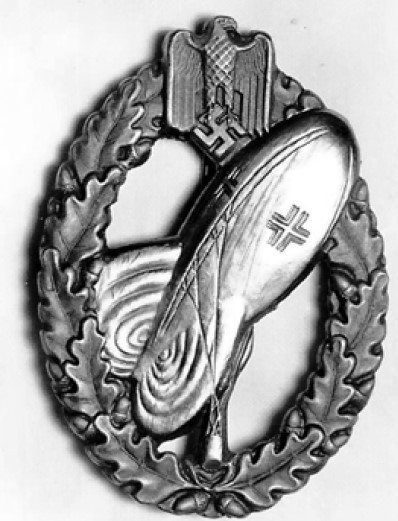
Any die-stamped badge is preceded by the tool die. It is to be regarded as unlikely that someone in the last months of the Third Reich wasted war-important material in order to produce such an elaborate die. Raw materials were subject to the strictest consumption rules and always had to be officially requested. So the badge must have been made after all. So how did the design of the badge come to life?
In contrast to the badges founded later, such as the Luftwaffe’s Close Combat Clasp of 3 November 1944 or the Luftwaffe’s Naval Combat Badge of 27 November 1944, the regulation on the introduction of the Balloon Observer Badge published on 8 July 1944 shows neither a description nor an illustration of the actual badge.
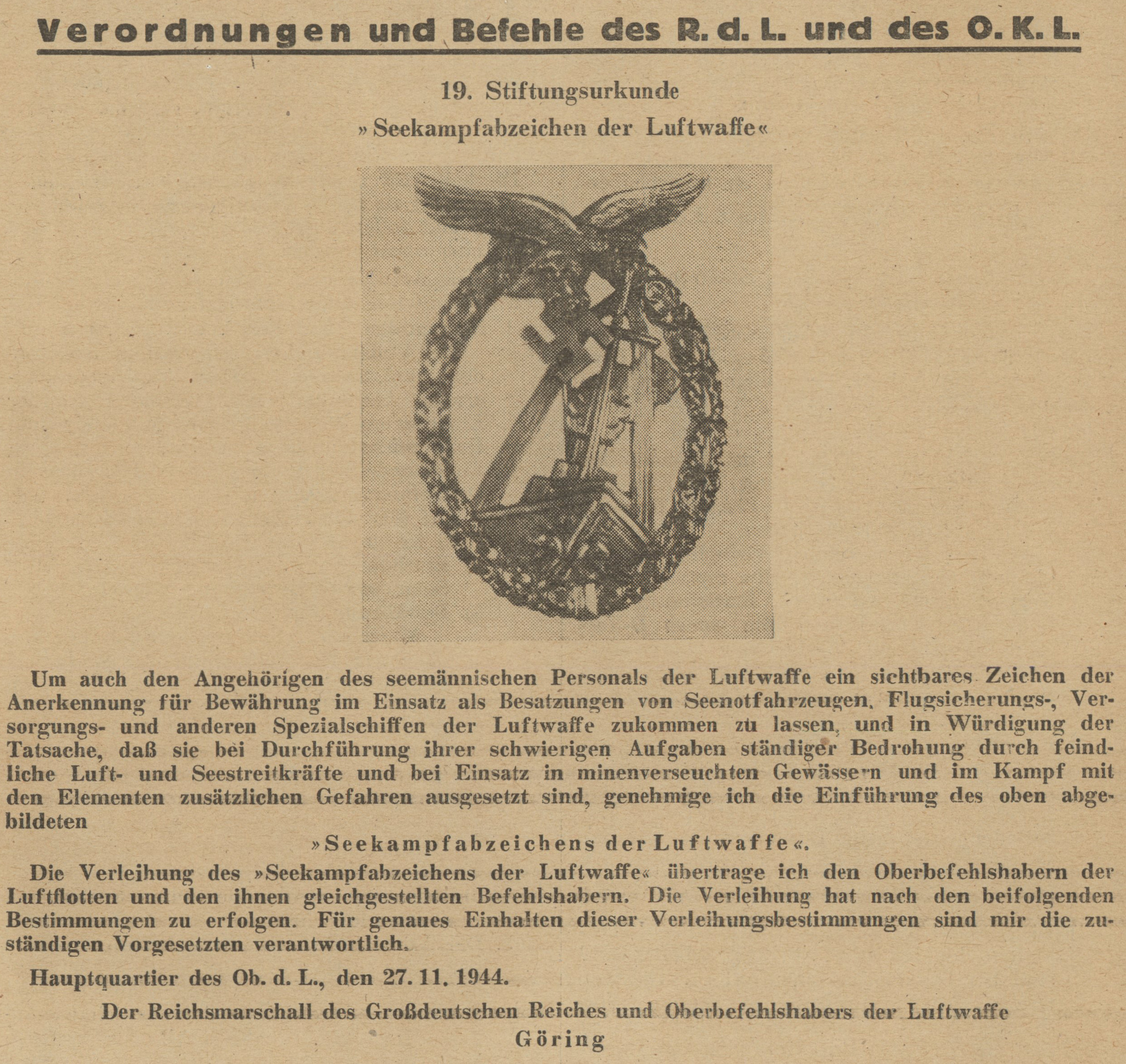
Froben writes on the subject of the design draft:
“[...] The announcement was then officially initiated after the matter had been presented to Adolf
Hitler (by General Schmundt) and a first version of the badge did not find approval.”15
His assistant Alfred Uhde on this:
"[...] I can remember that the OKH had various suggestions for the design of the badge, [...] “16
It is not unlikely that one or more artists provided design drafts and that prototypes were hand-made in order to generate a selection.
The graphic designs and prototypes17 of the Warschau Schild, which was only instituted in January 1945, are known. The artist assigned for this combat badge handcrafted two shield patterns with sheet metal. The shield is even mentioned in the January 1945 issue of the magazine Uniformen-Markt.18 However, there is no trace of the balloon observer’s badge in this or any other publication. In 2006 Klaus D. Patzwall published a letter in his magazine Militaria, Issue 3, which reads as follows:
High Command of the Army H. Qu. OKH, July 26, 1944
Pa/P5/ 1 Staffel
Mr. Ellmar Lang Aachen
Graphic artist Ludwigsalle 7
Attached is a prototype of the “Balloon Observer Badge,” instituted by the Führer. This sample has already been submitted to the Führer for decision, but did not find his approval. You are therefore asked to prepare a new design, taking the following into account:
1.) Outer shape and size according to the Combat Badges of the Heer. Worn on the left side of the chest as well.
2.) Size of the balloon smaller than on the attached badge, so that the oak wreath is not suppressed and disturbed in its beauty.
3.) Production in 3 grades, as it is a proficiency badge. However, a purely bronze, silver, and gold version must be rejected, since otherwise it would lead to comparisons with the levels of the Wound Badge. Possibly the balloon could be made of different alloys.
The attached sample badge can serve as a guide.
Please let us know whether you are able to take part in the design proposal.
-1- Attachment
Heil Hitler!
- Signature -
Colonel19
The initially submitted samples were actually rejected and requested correction. The demands to Mr. Lang are reflected in the Klietmann’s badge shown on the previous page. The owner of this badge, Max Aurich, speculated:
“I consider the Ballon Beobachter Abzeichen to be an original, just as the previous owner also thought. The gentleman concerned got it from the medal factory, in which he was during the war in Bln. employed. Precisely because the piece comes from there, it might be the RRR piece. It is a sample piece and hollow pressed to save metal at the time. But it is a piece from production after all, then certainly the only copy that escaped destruction during bombing because the gentleman in question needed it for his collection.
I have just received the following message from the previous owner of the Ballon Beobachter Abzeichen: I received the Balloon Observer Badge in 1943 from the Presidential Chancellery as a sample. I had received the order from the OKH to design an army badge, which, as far as I remember, was given for the shooting down of low-flying aircraft and was supposed to be in the style of the Balloon Observer Badge. This badge never made it to distribution.“
Mr. Aurich’s speculation shows various discrepancies: A) An employee has it from the order factory in Bln. (probably Berlin), which would indicate a final production. In the second paragraph, however, the employee becomes a designer who received a sample from the presidential office. B) The badge is said to have been sent “1943.” This is very unlikely, since its final form, according to the above descriptions by Froben, could only be available around mid-1944 and an unapproved sample could hardly have served as a model for another award. The low-flying aircraft destruction badge itself was instituted on 12 January 1945, six months after the Balloon Observer Badge.20
Did Max Aurich mix up a few facts in his euphoria as a collector or did he not recall them correctly?
Dr. Klietmann, in addition to his questionnaire, sent all his balloon observers photos of the obverse and reverse of the badge in the Aurich collection. Hans Joachim Froben replied in 1955 as follows:
“[…] The enclosed photos show the Balloon Observer Badge. I am not entirely sure whether this was the last version. At least it is the version that was accepted with small changes. At the time, a Dresden jeweler presented me with several designs. The one mentioned above was carried out. I think the name of the jeweler started with a Z. But I can just as easily be wrong. [...] “21
He also writes:
“[…] I think 50 examples were initially commissioned in bronze, 30 in silver, and 10 in gold. […] A list was kept at my department at the time, Gen. d. Art., Group III, but this was not dependably executed. I don’t know where the list went, since I was transferred to other uses in February 45. [...] “22
In the Deutsches Soldatenjahrbuch23 Colonel a.D. Hans Joachim Froben publishes a treatise on the Balloon Observer Badge: “The Order Department of the Personnel Office commissioned a Dresden jeweler to produce the Balloon Observer Badge. Of two samples submitted to me, I suggested one for production, 20-40 pieces should be made for each grade. From the Gen. d. Art. Balloon Observer Badges were awarded and award documents were sent out. I do not know whether the planned delivery of badges took place, as I took over an artillery regiment at the front again at the beginning of 1945.“
After a careful examination of all available facts, it becomes clear that the badge was instituted after the award criteria had been determined. It was awarded, award lists were kept, award documents were issued and the award was entered into the Soldbuch.
The badge itself went through the design process. Samples were presented, corrected at Hitler’s request and, according to contemporary witnesses, commissioned for production by a Dresden jeweler. Dresden was drowned in a hail of bombs on 13 February 1945. Badges made up to that point were very likely destroyed in the firestorm. The piece from the Max Aurich collection, a badge made from a die intended for mass production, has unfortunately only survived in the form of two photos taken by Dr. Klietmann and the badge itself, as published here. The author is not aware of any other badge, either in photographic or actual form, in private or public collections, or from the international medal trade.
One of the conflicting statements by Max Aurich, that it was sent to an artist as a sample for the design of a new badge, seems the least plausible. Based on the statements made by contemporaries that the badge was ordered and produced in Dresden, it would be one of the pieces made there.
The badge reflects all of Hitler’s wishes mentioned in the letter to Ellmar Lang, including the special request for a two-tone design. Klietmann writes about the Aurich badge in his book:
“The wreath with the national emblem was light brown and the balloon was tinted golden. The reverse showed a medium brown and a vertical pin.”24
The description on the reverse of the black and white images of the front and back of the badge in Max Aurich’s collection reads as follows:
“Template: Max Aurich Collection, Dortmund. Wreath with national eagle light brown, balloon is gold-plated. Reverse: medium brown. [...] “25
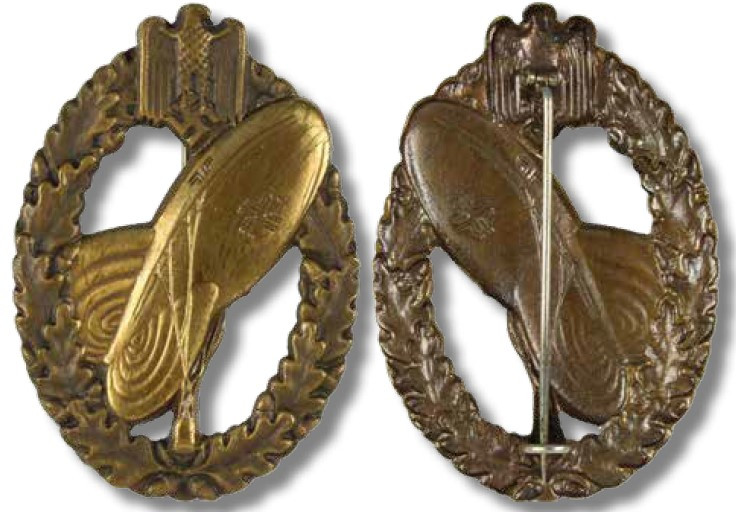
Following all currently known documents regarding the topic of Balloon Observer Badge are shown below. In contrast to the testimony of contemporary witnesses, the brave men were awarded War Merit Crosses and, above all, also Iron Crosses.
As already described above, Willibald Sellner received his Balloon Observer Badge 1. Grade on 12 December 1944. The original of his certificate was not available, but Dr. Klietmann photographed it for archiving and publication.
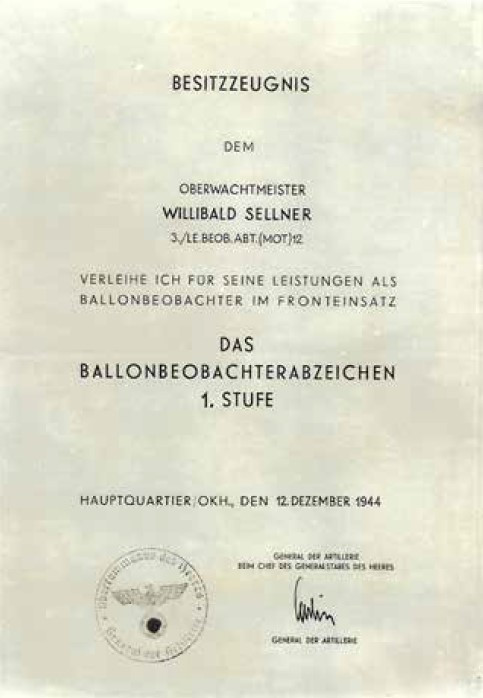

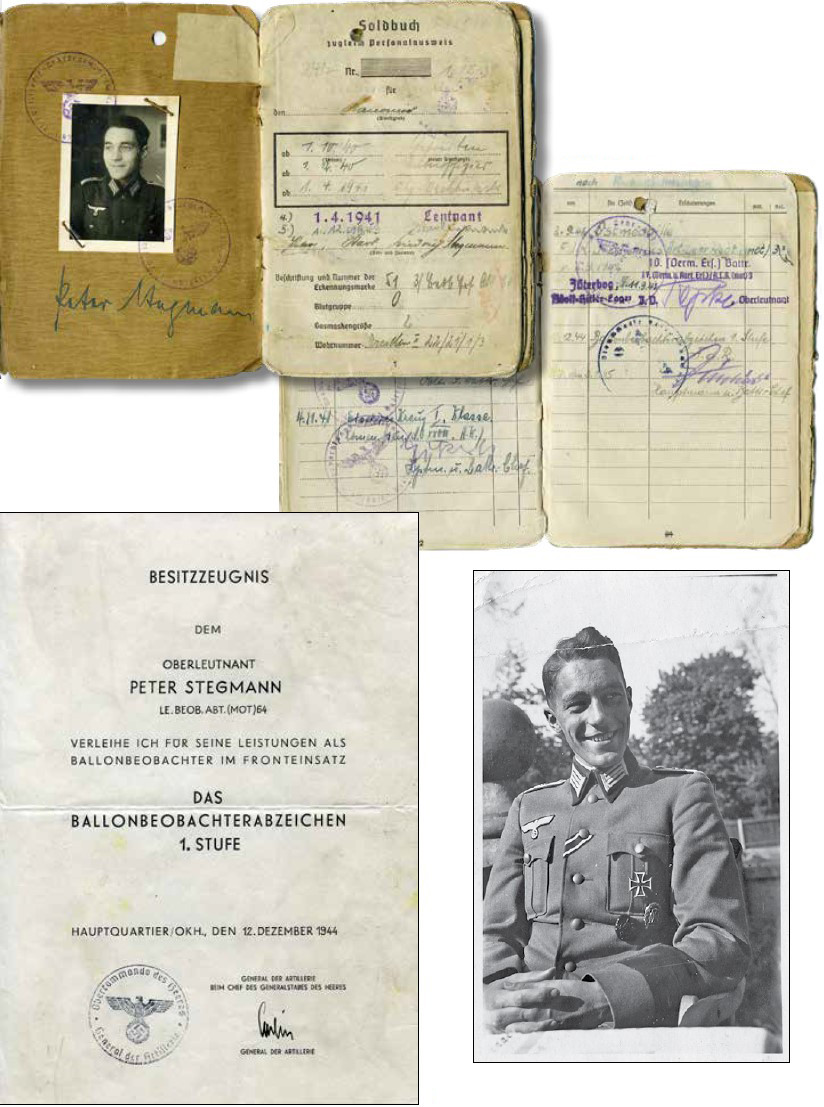
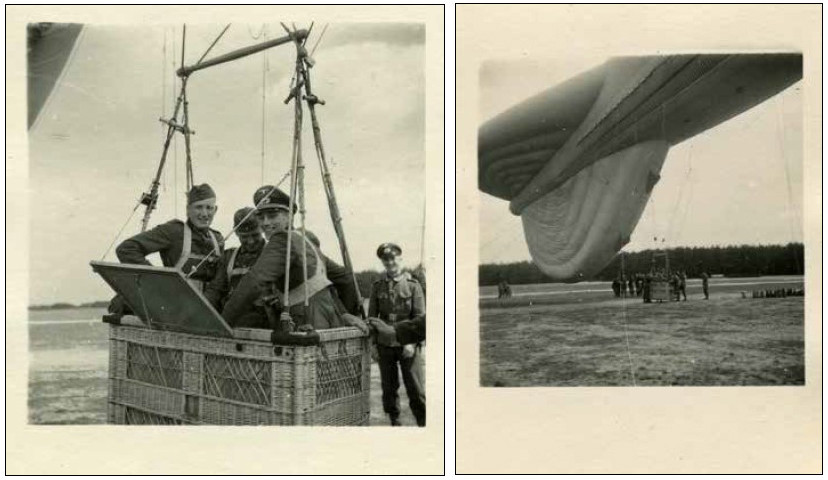
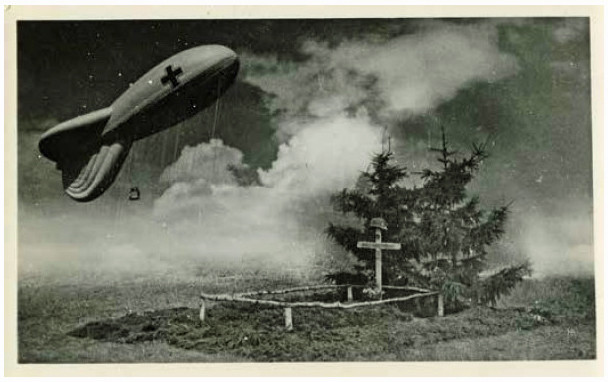
Footnotes:
1: Allgemeine Heeresmitteilungen, 11. volume, 18. edition, 7 August 1944, pages 236/237
2: in the archive of Herold of Berlin
3: Klietmann archive, file 308a, 124, attestation of A. Ramminger, March 1978
4: Klietmann archive, file 308a, 130, letter from Friedrich Wilhelm Schmidt, February 1956
5: Klietmann archive, file 308a, no number, letter from F. W. Schmidt, 2. answer, 17 June 1956
6: Klietmann archive, file 308a, 126, letter from H.J. Froben, 29. June 1955
7: Klietmann archive, file 308a, 126, letter from H.J. Froben, 29. June 1955
8: Klietmann archive, file 308a, 135, reply letter of Dr.-Ing. Alfred Uhde, 14. July 1955
9: Klietmann archive, file 308a, 139, letter from Peter K. Stegmann, 26. November 1958
10: Klietmann archive, file 308a, 131, letter from Rudolf Kessler, 1. December 1958
11: Aufklärende Artillerie, H.J. Froben, Schild Verlag 1972, history of Observer Unit 12, page 292
12: Klietmann archive, file 308a, 127, letter from Willibald Sellner, 27. May 1962
13: Klietmann archive, file 308a, 128, letter fromW. Sellner to Klietmann, 10. June 1962
14: Klietmann, Dr. K.-G., Deutsche Auszeichnungen, Vol. 2, Verlag Die Ordens-Sammlung, Berlin 1971
15: Klietmann archive, file 308a, 126, letter from H.J. Froben, 29. June 1955
16: Klietmann archive, file 308a, 135, reply letter of Dr.-Ing. Alfred Uhde, 14. July 1955
17: sample from Albin Scheer of Spring 1945 based on design by Benno von Arent
18: Deutsche Uniformen-Zeitschrift, Schwert und Spaten, and Uniformen-Markt, volume 1945, Berlin, Jan.45
19: Militaria, No.3, Vol. 29., May-June 2006, Das Ballonbeobachterabzeichen des Heeres, Stump, Spronk, Patzwall
20: Deutsches Reichsgesetzblatt, 1945, part 1, No.5, page 23
21: Klietmann archive, file 308a, 126, letter from H.J. Froben, 29. June 1955
22: Klietmann archive, file 308a, 126, letter from H.J. Froben, 29. June 1955
23: Deutsches Soldatenjahrbuch, No. 22, 1974, pages 135/136
24: Klietmann, Dr. K.-G., Deutsche Auszeichnungen, Vol. 2, Verlag Die Ordens-Sammlung, Berlin 1971
25: Klietmann archive, file 308a, 145, photos of the 1 Grade of the Balloon Observer Badge, Max Aurich Coll.
26: Auktionshaus Carsten Zeige, auction 13 April 2019, lot 444